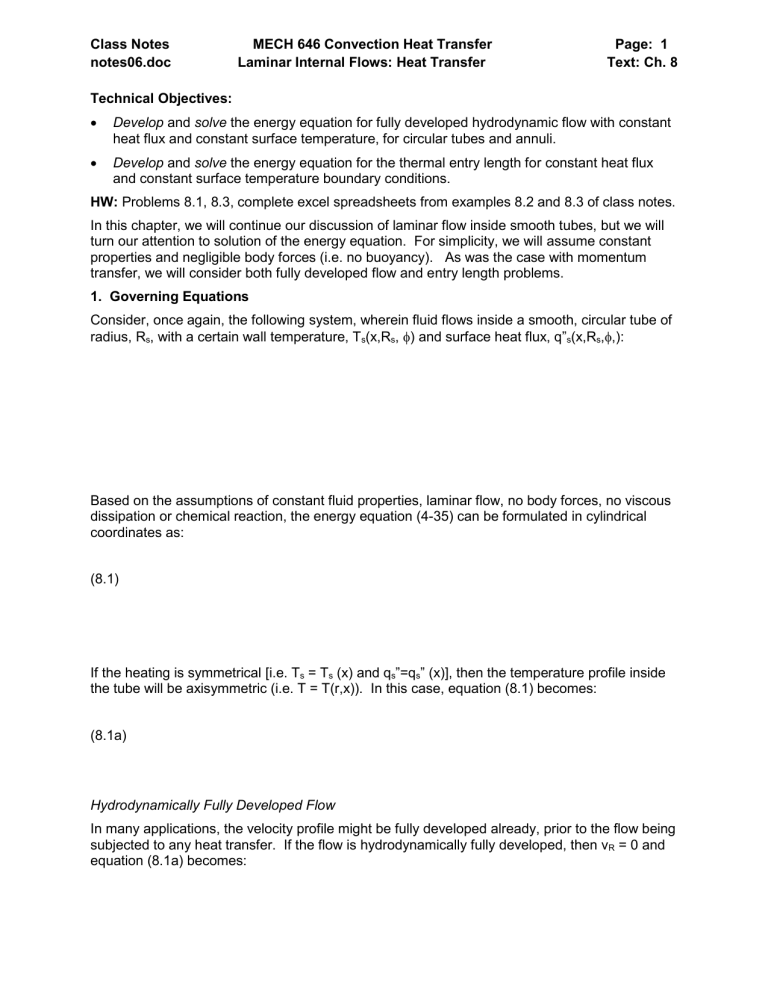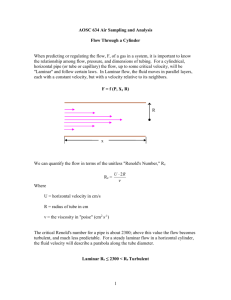notes06

Class Notes notes06.doc
MECH 646 Convection Heat Transfer
Laminar Internal Flows: Heat Transfer
Page: 1
Text: Ch. 8
Technical Objectives:
Develop and solve the energy equation for fully developed hydrodynamic flow with constant heat flux and constant surface temperature, for circular tubes and annuli.
Develop and solve the energy equation for the thermal entry length for constant heat flux and constant surface temperature boundary conditions.
HW: Problems 8.1, 8.3, complete excel spreadsheets from examples 8.2 and 8.3 of class notes.
In this chapter, we will continue our discussion of laminar flow inside smooth tubes, but we will turn our attention to solution of the energy equation. For simplicity, we will assume constant properties and negligible body forces (i.e. no buoyancy). As was the case with momentum transfer, we will consider both fully developed flow and entry length problems.
1. Governing Equations
Consider, once again, the following system, wherein fluid flows inside a smooth, circular tube of radius, R s
, with a certain wall temperature, T s
(x,R s
,
) and surface heat flux, q” s
(x,R s
,
,):
Based on the assumptions of constant fluid properties, laminar flow, no body forces, no viscous dissipation or chemical reaction, the energy equation (4-35) can be formulated in cylindrical coordinates as:
(8.1)
If the heating is symmetrical [i.e. T s
= T s
(x) and q s
”=q s
” (x)], then the temperature profile inside the tube will be axisymmetric (i.e. T = T(r,x)). In this case, equation (8.1) becomes:
(8.1a)
Hydrodynamically Fully Developed Flow
In many applications, the velocity profile might be fully developed already, prior to the flow being subjected to any heat transfer. If the flow is hydrodynamically fully developed, then v
R
= 0 and equation (8.1a) becomes:
Class Notes notes06.doc
MECH 646 Convection Heat Transfer
Laminar Internal Flows: Heat Transfer
Page: 2
Text: Ch. 8
(8.2)
In many cases, we can neglect axial conduction (this is an assumption…is it valid?), resulting in the following energy equation:
(8.3)
Before solving equation (8.3), it is convenient to introduce a few key parameters: massaveraged fluid temperature, T m
, and non-dimensional temperature ,
.
Mass-Averaged Fluid Temperature
The mass-averaged fluid temperature (or bulk mean temperature) is a way of characterizing average thermal energy of the fluid: results in the following formulation for mass-averaged fluid temperature:
(8-5)
Non-Dimensional Temperature
Next, we can define a non-dimensional temperature, with respect to the wall temperature, T s and average temperature T m
, as follows:
(8.5a)
2. Circular Tube with Fully Developed Velocity and Temperature Profiles
Under some very specific heating conditions, it is possible to have a fully developed nondimensional temperature profile, in which the non-dimensional temperature varies only with the radius. Under these conditions,
=
(r) only. The figure below shows an example of a fullydeveloped non-dimensional temperature profile:
Class Notes notes06.doc
MECH 646 Convection Heat Transfer
Laminar Internal Flows: Heat Transfer
Page: 3
Text: Ch. 8
If
=
(r), then the gradient (d
/dr) rs
at the wall must be everywhere a constant:
Evaluating the above derivative, we get:
(8.6a)
Next, we define a heat transfer coefficient with respect to the bulk mean temperature:
(8.6)
Given the definition of wall heat flux, equation (8.6) really means that the heat transfer coefficient is defined, in this case, as:
(8.6b)
Comparing equations (8.6a) and (8.6b) shows that, for a fully-developed temperature profile, the heat transfer coefficient, h is a constant.
If, in fact, there exists conditions in which
=
(r) only, then, by definition d
/dx = 0. Note, this does not necessarily mean that T, T m
or T s
do not vary with x:
Evaluating the above derivative, we get:
Class Notes notes06.doc
MECH 646 Convection Heat Transfer
Laminar Internal Flows: Heat Transfer
Page: 4
Text: Ch. 8
Which, we can be solved for dT/dx:
(8-7)
We can then substitute (8-7) into the left hand side of equation (8-4):
(8.4a)
2.1 Constant Surface Heat Flux
This boundary condition arises often in practice (e.g. resistive heating). Since, as discussed above, heat transfer coefficient is a constant, then T s
-T m
must also be a constant:
From which it follows that:
Eliminating dT m
/dx from equation (8.7) shows that:
(8-8)
Substituting into equation (8-4a), results in the differential equation that can be solved for constant surface heat flux:
(8-10)
Class Notes notes06.doc
MECH 646 Convection Heat Transfer
Laminar Internal Flows: Heat Transfer
Page: 5
Text: Ch. 8
2.2 Constant Surface Temperature
Another very common boundary condition is the constant surface temperature condition. By definition, if T s
= a constant, then dT s
/dx = 0 and equation (8-7) becomes:
(8-9)
Substituting (8-9) into (8-4a) yields the differential equation that can be solved for the constant surface temperature problem:
(8-19)
3. The Constant Heat Rate Solution
As developed in §2.2, the equation to be solved for hydrodynamically fully developed and thermally fully developed flow is:
(8-10)
Subject to the following boundary conditions:
(8-10a)
Since the flow is hydrodynamically fully developed, we already know the velocity profile, u(r):
(7-8)
Substituting (7-8) into (8-10) yields:
(8-11a)
This is a second-order, separable differential equation for T with respect to r, which can be integrated twice as follows:
Class Notes notes06.doc
MECH 646 Convection Heat Transfer
Laminar Internal Flows: Heat Transfer
Page: 6
Text: Ch. 8
(8-11)
Although, we don’t yet know the value of dT m
/dx, equation 8-11 tells us the form of the temperature profile T(r).
Next, we can evaluate T m
given u(r) and T(r):
(8-12)
Substituting (8-11) and (7-8) for T(r) and u(r), respectively, and integrating yields:
Class Notes notes06.doc
MECH 646 Convection Heat Transfer
Laminar Internal Flows: Heat Transfer
Page: 7
Text: Ch. 8
(8-13)
Recalling the definition of the heat transfer coefficient, we can relate the surface heat flux to the mean temperature, T m
, as:
(8-14)
Lastly, we can eliminate dT m
/dx by performing an overall control volume analysis:
Class Notes notes06.doc
MECH 646 Convection Heat Transfer
Laminar Internal Flows: Heat Transfer
Page: 8
Text: Ch. 8
(8-15)
We can combine (8-15) with (8-14), which eliminates dT m
/dx and we can solve for the heat transfer coefficient, h:
(8-16)
So, for the case of laminar flow, constant surface heat flux, hydrodynamically fully developed flow and thermally fully developed flow, we have the simple solution of constant heat transfer coefficient, which is a function only of the thermal conductivity, k, and the pipe diameter, D.
How can this be?
4. The Concentric Circular Tube Annulus with Hydrodynamic and Thermally Fully
Developed Flow and Constant Wall Heat Flux
Consider next the following circular tube annulus:
Class Notes notes06.doc
MECH 646 Convection Heat Transfer
Laminar Internal Flows: Heat Transfer
Page: 9
Text: Ch. 8
The differential equation (8-10) for the constant surface heat flux problem is still valid and can be solved again:
(8-10)
For the circular annulus case, it can be shown that the velocity profile is:
(8-26)
Where B and M are constants related to the geometry of the annulus:
Substituting (8-26) into (8-10) yields the energy equation that needs to be solved:
(8-27)
As was the case in §3, equation (3-27) can be directly integrated twice and solved via superposition. Specifically, it is possible to solve the case for heating one of the surfaces, with the other surface completely insulated, then solve the opposite case, and add the solutions.
Without going through all of the algebra, the solution will be provided here. First, we define the heat transfer coefficients at each surface as follows:
Next, we define Nusselt numbers for both the inner and outer surfaces as:
Where D h
is the hydraulic diameter, which is equal to the following for an annulus:
Class Notes notes06.doc
MECH 646 Convection Heat Transfer
Laminar Internal Flows: Heat Transfer
Page: 10
Text: Ch. 8
If we define Nu ii
as the Nusselt number for the case where the inner tube is heated and the outer tube is insulated and Nu oo
as the Nusselt number for the case where the outer tube is heated and the inner tube is insulated, the solutions for any heat flux conditions can be expressed in the following form:
(8-28)
(8-29)
Where the parameters
* o
and
* i
are functions only of r i
/r o
. The complete set of solutions for (8-
28) and (8-29) for fully developed laminar flow in an annulus are provided in Table 8-1 of your text. r i
/r o
0
0.05
0.10
0.20
0.40
0.60
0.8
1.00
Nu ii
∞
17.81
11.91
8.499
6.583
5.912
5.58
5.385
Nu oo
4.364
4.792
4.834
4.883
4.979
5.099
5.24
5.385
* i
∞
2.18
1.383
0.905
0.603
0.473
0.401
0.346
* o
0
0.0294
0.0562
0.1041
0.1823
0.2455
0.299
0.346
Example 8.1
Air flows a mass flow rate of 0.005 kg/s at 300 K enters an annulus with an inner diameter of 1 cm and outer diameter of 5 cm. Heat is added to the air at the inner surface at a heat flux of 100 W/m 2 and heat is removed from the outer surface at 50 W/m 2 . Calculate the temperature of the inner and outer surfaces after 10 meters.
Class Notes notes06.doc
MECH 646 Convection Heat Transfer
Laminar Internal Flows: Heat Transfer
Page: 11
Text: Ch. 8
4.1 Parallel Planes with Hydrodynamic and Thermally Fully Developed Flow and Constant
Wall Heat Flux
A similar solution can be developed for hydrodynamically and thermally fully developed flow between parallel planes, with constant wall heat flux:
In this case, the Nusselt numbers can be shown to be:
Class Notes notes06.doc
MECH 646 Convection Heat Transfer
Laminar Internal Flows: Heat Transfer
Page: 12
Text: Ch. 8
5. Circular Tube Thermal Entry Length Solutions
So far, we have found that for thermally and hydrodynamically fully develop flow situations, the heat transfer coefficient, h, does not vary with length. Next, we consider a more general situation wherein the flow is hydrodynamically fully developed but not thermally fully developed.
This can occur in practice in 2 situations:
1. Fluid with a constant inlet temperature and fully developed velocity profile encounters a sudden change in heat transfer (i.e. change in wall temperature or the introduction of a wall heat flux).
2. Fluids with Pr ≥ 5, in which case the velocity profile develops much quicker than the thermal profile.
Note on Prandtl Number. Prandtl number is defined as the ratio of kinematic viscosity to thermal diffusivity:
Liquid metals have very low Prandtl numbers because of their high thermal conductivity, viscous oils have a very high Prandtl number because of their high viscosity, and gases have Prandtl numbers near 1.
Class Notes notes06.doc
MECH 646 Convection Heat Transfer
Laminar Internal Flows: Heat Transfer
Page: 13
Text: Ch. 8
5.1 Thermal Entry Length Solution with Uniform Surface Temperature
First, we look at the case of uniform surface temperature, T s
, with a uniform entry temperature,
T e
.
Since the flow is hydrodynamically fully developed, v r
= 0, and the applicable governing equation is:
(8.3)
Next, we non-dimensionalize this equation by introducing a non-dimensional temperature,
, which is defined as follows (Note that this definition is slightly different than 8.5a):
(8-31a)
Note that T s
and T e
are constant in this particular case.
Next, we introduce a non-dimensional radius, r + , non-dimensional axial position, x + and nondimensional velocity, u + :
(8-31b)
Substituting the non-dimensonal variables (8-31a and 8-31b) into (8.3), yields the nondimensional form of the governing equation:
(8-31)
The non-dimensional form of the equation suggests that for large values of RePr, the axial conduction term can be ignored. Consider, for example, air at a Reynolds number of 100:
Class Notes notes06.doc
MECH 646 Convection Heat Transfer
Laminar Internal Flows: Heat Transfer
Page: 14
Text: Ch. 8
Since the flow is hydrodynamically fully developed and laminar, we already know the velocity profile u(r) from (7-8):
(7-8) which can be converted to non-dimensional form as follows:
(8-31c)
Substituting (8-31c) into (8-31) and ignoring the axial conduction term yields the final form of the differential equation:
(8-32) which can be solved, subject to the following boundary conditions:
(8-32b)
Without solving the equation, we can already begin to think about the solution:
Class Notes notes06.doc
MECH 646 Convection Heat Transfer
Laminar Internal Flows: Heat Transfer
Page: 15
Text: Ch. 8
Equation (8-32) can be solved via the separation of variables technique:
Substituting into (8-32) yields:
(8-32c)
Dividing by XR, yields:
(8-32d)
Since the left hand side of (8-32a) is a function only of x + and the right hand side is a function only of r + , then both sides of the equation must be equal to a constant, which we call
2 :
(8-32e)
This results in two separate ordinary differential equations:
(8-32f)
(8-32g)
Equation (8-32f) is a simple, first order, homogeneous ordinary differential equation, which has the following solution:
(8-32h)
Equation (8-32g) is a Sturm-Liouville equation, which can be solved via an infinite series solution. The final form of the solution
(x + ,r + ) takes the final form:
(8-36)
Class Notes notes06.doc
MECH 646 Convection Heat Transfer
Laminar Internal Flows: Heat Transfer
Page: 16
Text: Ch. 8
Where
n
are eigenvalues, R n
(r + ) are eigenfunctions and C n
are constants.
The surface heat flux can be evaluated by taking the derivative of the temperature profile with respect to r + at the wall as follows:
(8-37a)
Evaluating the surface heat flux from equation (8-36) results in:
(8-37b) which can be expressed as:
(8-37) where the constants G n
and
n
are tabulated in Table 8-3. Because of the exponential term, the infinite series converges after only several terms.
It can also be shown that the bulk mean temperature,
m
, can be evaluated to be:
(8-38)
Finally, we can evaluate the local Nusselt number, Nu x
,
(8-33)
(8-39)
And the mean Nusselt number, Nu m
, as follows:
(8-35)
(8-40)
Class Notes notes06.doc
MECH 646 Convection Heat Transfer
Laminar Internal Flows: Heat Transfer
Page: 17
Text: Ch. 8
Example 8-2. Air at 300 K enters a 3/4” tube at a Re=500 and a constant surface wall temperature of 600 K. Calculate and plot q s
”(x), T m
(x), Nu x
and h for the first 24 inches of tubing.
Class Notes notes06.doc
MECH 646 Convection Heat Transfer
Laminar Internal Flows: Heat Transfer
Page: 18
Text: Ch. 8
5.2 Thermal Entry Length Solution with Uniform Heat Flux
A solution to the thermal entry length problem with uniform surface heat flux can be developed in a similar manner to the constant surface temperature problem. In this case, we solve the same energy equation:
(8-32) but, since T s
is no longer a constant, it makes more sense to define the non-dimensional temperature as follows:
(8-42a)
By employing the separation of variables technique as previously, it can be shown that the following solution is obtained for Nu x
:
(8-42)
The eigenvalues,
m
and constants, A m
, for use in equation (8-42) are given in Table 8-5.
Equation (8-42) can be used, for example, to determine the surface temperature of a tube as a function of distance:
(8-42b)
Example 8.3. Air at 300 K and 1 atm enters a 3/4” tube at a Re=500 and a surface heat flux of
50 W/m 2 . Calculate and plot T m
(x), Nu x
and T s
(x) for the first 24 inches of tubing.
Class Notes notes06.doc
MECH 646 Convection Heat Transfer
Laminar Internal Flows: Heat Transfer
Page: 19
Text: Ch. 8





